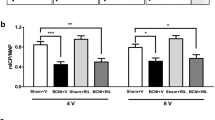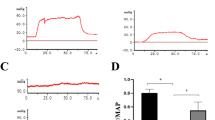Abstract
To evaluate whether FK506 and other immunophilin ligands may have potential therapeutic efficacy for erectile function preservation after penile nerve injury, we demonstrated localizations of the immunophilin FK506 binding protein 12 (FKBP 12) in intact and injured rat penile nerves and correlated these findings with localizations of neuronal nitric oxide synthase (nNOS), which neuronally forms nitric oxide for mediation of penile erection, in response to systemically administered FK506. Adult male Sprague–Dawley rats were subjected to unilateral right cavernous nerve forceps crush injury and administered FK506 (1 mg/kg i.p.) or saline at the same time and daily up to 7 days. At 1, 3 and 7 days after injury, bilateral cavernous nerves and major pelvic ganglia were collected for nNOS immunohistochemistry, FKBP 12 immunohistochemistry, and FKBP 12 in situ hybridisation. Protein expressions of nNOS and FKBP 12 were observed in major pelvic ganglion, cavernous nerve and nerve terminals within the rat penis as well as mRNA expression of FKBP 12 observed in the rat major pelvic ganglion neuronal cell bodies to a minimal extent at baseline conditions. After cavernous nerve injury, nNOS immunoreactivity was observed to be slightly diminished in ipsilateral penile nerve structures at only one day following injury while both FKBP 12 protein and mRNA expressions were observed to be increased at each interval of study. FK506 treatment did not affect staining of intact or injured nerves. Our demonstration that FKBP 12 is localized to penile innervation in the rat and becomes upregulated following cavernous nerve crush injury, independent of FK506 treatment, suggests that this immunophilin mediates a neurotrophic mechanism. Whether FK506 affords neuroprotection that preserves penile erection through FKBP 12 upregulation is unclear.
This is a preview of subscription content, access via your institution
Access options
Subscribe to this journal
Receive 8 print issues and online access
$259.00 per year
only $32.38 per issue
Buy this article
- Purchase on Springer Link
- Instant access to full article PDF
Prices may be subject to local taxes which are calculated during checkout



Similar content being viewed by others
References
Schreiber SL . Chemistry and biology of the immunophilins and their immunosuppressive ligands Science 1991; 251: 283–287.
Schreiber SL, Crabtree GR . Immunophilins, ligands, and the control of signal transduction Harvey Lect 1995; 91: 99–114.
Marks AR . Cellular functions of immunophilins Physiol Rev 1996; 76: 631–649.
Steiner JP et al. High brain densities of the immunophilin FKBP colocalized with calcineurin Nature 1992; 358: 584–587.
Dawson TM et al. The immunophilins, FK506 binding protein and cyclophilin, are discretely localized in the brain: relationship to calcineurin Neuroscience 1994; 62: 569–580.
Sharkey J, Butcher SP . Immunophilins mediate the neuroprotective effects of FK506 in focal cerebral ischaemia Nature 1994; 371: 336–339.
Lyons WE et al. Immunosuppressant FK506 promotes neurite outgrowth in cultures of PC12 cells and sensory ganglia Proc Natl Acad Sci USA 1994; 91: 3191–3195.
Gold BG, Katoh K, Storm-Dickerson T . The immunosuppressant FK506 increases the rate of axonal regeneration in rat sciatic nerve J Neurosci 1995; 15: 7509–7516.
Ide T, Morikawa E, Kirino T . An immunosuppressant, FK506, protects hippocampal neurons from forebrain ischemia in the mongolian gerbil Neurosci Lett 1996; 204: 157–160.
Steiner JP et al. Neurotrophic immunophilin ligands stimulate structural and functional recovery in neurodegenerative animal models Proc Natl Acad Sci USA 1997; 94: 2019–2024.
Lee M, Doolabh VB, Mackinnon SE, Jost S . FK506 promotes functional recovery in crushed rat sciatic nerve Muscle Nerve 2000; 23: 633–640.
Freeman EE, Grosskreutz CL . The effects of FK506 on retinal ganglion cells after optic nerve crush Invest Ophthalmol Visual Sci 2000; 41: 1111–1115.
Kihara M et al. A small dose of the immunosuppressive agent FK506 (tacrolimus) protects peripheral nerve from ischemic fiber degeneration Muscle Nerve 2001; 24: 1601–1606.
Steiner JP et al. Neurotrophic actions of nonimmunosuppressive analogues of immunosuppressive drugs FK506, rapamycin and cyclosporin A Nat Med 1997; 3: 421–428.
Sabatini DM, Lai MM, Snyder SH . Neural roles of immunophilins and their ligands Mol Neurobiol 1997; 15: 223–239.
Hamilton GS, Steiner JP . Immunophilins: beyond immunosuppression J Med Chem 1998; 41: 5119–5143.
Gold BG . Neuroimmunophlin ligands: evaluation of their therapeutic potential for the treatment of neurological disorders Expert Opin Invest Drugs 2000; 9: 2331–2342.
Sezen SF, Hoke A, Burnett AL, Snyder SH . Immunophilin ligand FK506 is neuroprotective for penile innervation Nat Med 2001; 7: 1073–1074.
Walsh PC, Marschke P, Ricker D, Burnett AL . Patient-reported urinary continence and sexual function after anatomic radical prostatectomy Urology 2000; 55: 58–61.
Burnett AL et al. Nitric oxide-dependent penile erection in mice lacking neuronal nitric oxide synthase Mol Med 1996; 2: 288–296.
Blackshaw S, Snyder SH . Parapinopsin, a novel catfish opsin localized to the parapineal organ, defines a new gene family J Neurosci 1997; 17: 8083–8092.
Lai MM et al. Cain, a novel physiologic protein inhibitor of calcineurin J Biol Chem 1998; 273: 18325–18331.
Burnett AL et al. Nitric oxide: a physiologic mediator of penile erection Science 1992; 257: 401–403.
Lyons WE, Steiner JP, Snyder SH, Dawson TM . Neuronal regeneration enhances the expression of the immunophilin FKBP-12 J Neurosci 1995; 15: 2985–2994.
Carrier S et al. Regeneration of nitric oxide synthase-containing nerves after cavernous nerve neurotomy in the rat J Urol 1995; 153: 1722–1727.
El-Sakka AI et al. Effect of cavernous nerve freezing on protein and gene expression of nitric oxide synthase in the rat penis and pelvic ganglia J Urol 1998; 160: 2245–2252.
Podlasek CA et al. Analysis of NOS isoform changes in a post radical prostatectomy model of erectile dysfunction Int J Impot Res 2001: 13: (Suppl 5) S1–S15.
Quinlan DM et al. The rat as a model for the study of penile erection J Urol 1989; 141: 656–661.
Burnett AL . Nitric oxide in the penis: physiology and pathology J Urol 1997; 157: 320–324.
Jung GW, Spencer EM, Lue TF . Growth hormone enhances regeneration of nitric oxide synthase-containing penile nerves after cavernous nerve neurotomy in rats J Urol 1998; 160: 1899–1904.
Jung GW et al. The role of growth factor on regeneration of nitric oxide synthase (NOS)-containing nerves after cavernous neurotomy in the rats Int J Impot Res 1999; 11: 227–235.
Jung GW et al. IGF-I and TGF-beta2 have a key role on regeneration of nitric oxide synthase (NOS)-containing nerves after cavernous neurotomy in rats Int J Impot Res 1999; 11: 247–259.
Bakircioglu ME et al. The effect of adeno-associated virus mediated brain derived neurotrophic factor in an animal model of neurogenic impotence J Urol 2001; 165: 2103–2109.
Gold BG et al. Immunophilin FK506-binding protein 52 mediates the neurotrophic action of FK506 J Pharmac Exp Ther 1999; 289: 1202–1210.
Acknowledgements
Supported by National Institute of Health grant DK 02568 (National Institute of Diabetes and Digestive and Kidney Diseases) and National Kidney Foundation-Maryland Research grant.
Author information
Authors and Affiliations
Corresponding author
Rights and permissions
About this article
Cite this article
Sezen, S., Blackshaw, S., Steiner, J. et al. FK506 binding protein 12 is expressed in rat penile innervation and upregulated after cavernous nerve injury. Int J Impot Res 14, 506–512 (2002). https://doi.org/10.1038/sj.ijir.3900919
Received:
Accepted:
Published:
Issue Date:
DOI: https://doi.org/10.1038/sj.ijir.3900919
Keywords
This article is cited by
-
Verbessert Tacrolimus die erektile Funktion nach nervschonender radikaler Prostatektomie?
Der Urologe (2019)
-
Peptidomics and Secretomics of the Mammalian Peripheral Sensory-Motor System
Journal of the American Society for Mass Spectrometry (2015)
-
Increased expression of nestin in the major pelvic ganglion following cavernous nerve injury
International Journal of Impotence Research (2012)
-
Sexual dysfunction after pelvic surgery
International Journal of Impotence Research (2006)
-
Neuromodulatory drugs for the radical prostatectomy patient: Current and future applications
Current Sexual Health Reports (2006)



